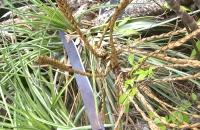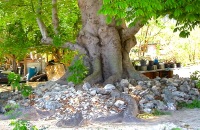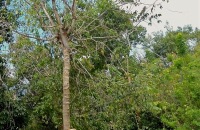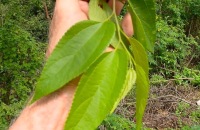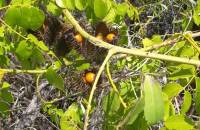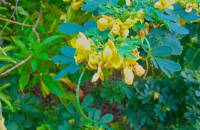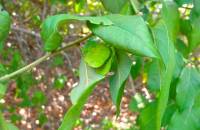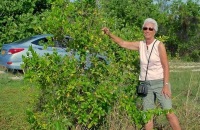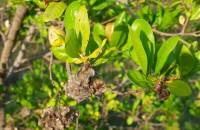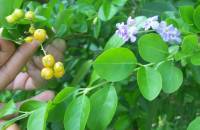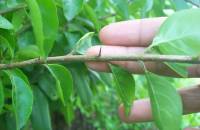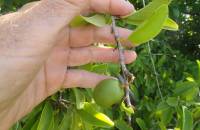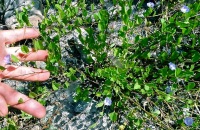KNOWN BUT NOT SHOWN:
These Wild Plants are on Cayman Brac too!
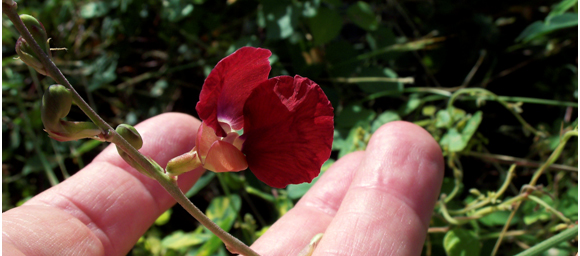
Tephrosia cineria (exists in at least 3 marsh locations on Cayman Brac)
Botanists have catalogued most of the wild plants in this country. The definitive works are Dr. George Proctor’s Flora of the Cayman Islands, second edition, and F.J. Burton’s Threatened Plants of the Cayman Islands: The Red List. For the complete citation of both books you may check the “field guides” section of this present nature blog, www.naturenotes19n79w.ky
But a book is no sooner published than it is out of date. It’s not a complaint, it’s a “thank you” because the books make it easier for amateur and professional plant sleuths to develop their knowledge. In the process they may find gaps or errors.
One such gap is the listings for Cayman Brac. Many plants that live here in the wild are credited in the references for Grand Cayman, Little Cayman or both but not for Cayman Brac. These plants have been here all along but have been missed. And no wonder — this island has few resident scientists, is difficult for scientists to get to and expensive for them to stay.
The present article is an attempt to catalogue these “missings”. Several have already been reported, collected for the National Herbarium, and noted for future editions. But all the ones we know will be published here and now. More will be found as we explore.
We have omitted some decorative plants that may have been brought by people, unless they have become completely naturalized.
Herewith, the incomplete list of plants that are “Known But Not Shown” – native plants that are known to exist in the wild on Cayman Brac, are credited to other Cayman Islands in the reference books but are not credited to Cayman Brac in the Flora of the Cayman Islands, Second Edition, Kew, Kew Publishing, 2012. We call the list “Known But Not Shown”.
Please read acknowledgements at the end of the table, enjoy the photographs and take a few steps into our dry, limestone forest, locally called “the bush”. It is delightful.
Below is the list of plants confirmed to exist in the wild on Cayman Brac, but not attributed to the Brac in the standard reference: Flora of the Cayman Islands, by G.R. Proctor, Kew Gardens, Kew, UK, 2012 even though credited to one or both of the other islands.
A separate column shows the status in the second standard refence, namely the table of native plants appended to Threatened Plants of the Cayman Islands, Kew Publishing, Kew 2008, by Frederick J. Burton.
Download complete plant table (with location on Cayman Brac) in pdf format
Listed on Cayman Brac in publications (Proctor; also Burton)?
| Scientific name | Common name | Family | Proctor | Burton | Local Photo? |
| Acrostichum aureum | Polypodiaceae | No | Yes | Yes | |
| Bromelia pinguin | Pingwing | Bromeliaceae | No | No | Yes |
| Buxus bahamensis | Boxwood | Buxaceae | No | No | Yes |
| Caesalpina wrightiana | Yellow nicker | Leguminosae | No | No | Yes |
| Caesalpina intermedia | Yellow nicker | (caesalpinioideae) | No | No | Yes |
| Canavalia nitida | Horse bean | Leguminosae | No | No | N/A |
| Ceiba pentranda | Kapok, Silk cotton tree | Malvaceae | No | Not listed | Yes |
| Celtis trinervia | Bastard fustic | Ulmaceae | No | No | Yes |
| Chamaecrista lineat | Storm weed | Leguminosae | No | No | Yes |
| Comocladia dentata | Maiden plum | Anacardiaceae | No | Yes | N/A |
| Cucumus anguria | Wild cucumber | Cucurbitaceae | No | Not listed | Yes |
| Dalbergia ecastaphyllum | Coin seed | Leguminosae | No | No | Yes |
| Dodonaea viscosa | Varnish leaf | Sapindaceae | No | No | Yes |
| Duranta erecta | Forget-me not (Jam.) | Verbenaceae | No | No | Yes |
| Elaeodendron xylocarpum | Wild calabash | Celastraceae | No | No | Yes |
| Encyclii kingsii | Orchidaceae | No | No | N/A | |
| Evolvulus convolvuloides | Convolvulaceae | No | No | Yes | |
| Exostema carbiaeum | Bastard ironwood | Rubiaceae | No | Yes | N/A |
| Ipomoea hederifolia | Convolvulacaea | No | Not listed | Yes | |
| Jacquinia keyensis | Wash-wood | Theophrastaceae | No | yes | Yes |
| Metopium toxiferum | Poison tree | Anacardiaceae | No | No | Yes |
| Morinda royoc | Yellow root | Rubiaceae | No | No | Yes |
| Oeceoclades maculata | Oeceoclades maculata | No | No | Yes | |
| Ocimum micranthum | Duppy basil (pimento basil) | Labiatae | No | No | N/A |
| Phyllanthus nutans, nutans | Euphorbiaceae | No | Yes | Yes | |
| Polygala propinqua | Polygalaceae | No | Yes | N/A | |
| Sapindus saponaria | Soap-berry, Black Nicker | Sapindaceae | No | Not listed | N/A |
| Securinega acidoton | Green ebony | Euphorbiaceae | No | No | N/A |
| Sideroxylon foetidissimum | Mastic | Sapotaceae | No | Yes | N/A |
| Smilax havanensis | Wire wiss | Smilacaceae | No | No | N/A |
| Tabernaemontana laurifolia | Wild jasmine | Apocynaceae | No | No | N/A |
| Tephrosia cineria | Faboideae | No | No | Yes | |
| Tillandsia paucifolia | Bromeliaceae | No | Yes | Yes (i.d. provided by F.J. Burton) | |
| Tillandsia setacea | Bromeliaceae | No | No | Yes (from print photo sent to F.J. Burton) | |
| Tillandsia recurvata | Bromeliaceae | No | Yes | Yes (but camera lost in the bush and could not be found) | |
| Typha domingensis | Cat-tail, rush | Typhaceae | No | No | N/A |
| Vanilla claviculata | Vanilla orchid | Orchidaceae | No | No | Yes |
| Zanthoxylum flavum | Yellow sanders, Satinwood | Rutaceae | No | Yes | Yes |
| Zephryanthes citrina | Yellow crocus | Amaryllidaceae | No | Not listed | Yes |
| Zephyranthes tubispatha | Amaryllidaceae | No | Not listed | Yes |
Total: 39 species
This list will never be complete. Others native plants not in the book will be identified on Cayman Brac. Also, please note that some decorative plants (Star-of-Bethlehem for example) listed in Dr. Proctor’s Flora have not been included here. (He lists it for Grand Cayman but not for the Brac where planting has made it common.)
Field work has progressed as a team, but often in twos or threes: Doug Ross, Doris Black, Edna Platts, Lynn Ferguson-Sage, Kathleen Bodden-Harris, Patti Sowell and others have contributed, and especially Isabelle Brown
Assistance in plant identification has come from the above plus Stuart Mailer, Fred Burton, Ann Stafford, Paul Watler, Lois Blumenthal, and the great Dr. Proctor in the early days.
Fewer than half these plants have been lodged with the National Herbarium, so an error factor may exist. The author has tried to keep it to zero; he will lead any interested party to the sites.
GPS readings have not been published for the sake of plant security. Ripping plants from the bush has been a problem.
All photos have been taken on Cayman Brac by the author. Both the blog and the article are the property of the author. Written permission is required for significant extracts.
Please note: From boyhood, every bird book or other reference had adjured me to take steps to preserve the natural world of which we are one part. You and I have not done enough.
We are losing it — over-populating and overrunning the natural world shown in these photos. Can we work together to do more ? It’s fun — our dry, limestone forest is astounding.
The author is grateful for the fine assistance rendered in producing and maintaining this blogsite since its inception, and for its benign corporate sponsorship.
J. Wallace Platts
Oct. 5, ’14

